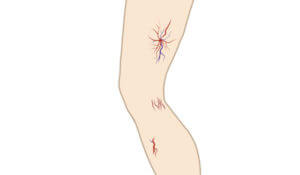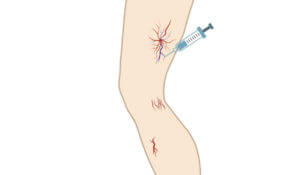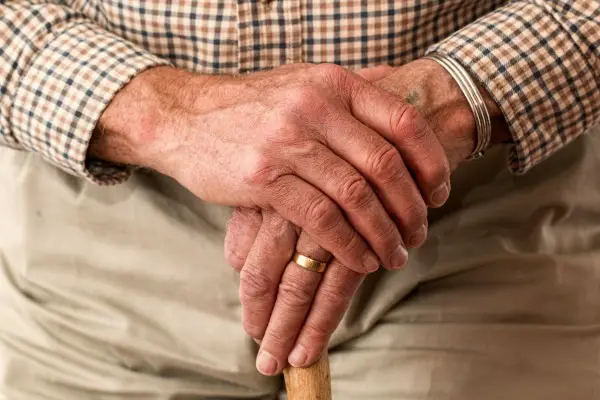Spider veins, or telangiectasias, are a group of dilated superficial veins that look like a bluish or reddish spiderweb near the surface of your skin. These small superficial vessels are not palpable and are most commonly found in lower extremities, such as the thighs, ankles, and feet. Occasionally spider veins appear on the face, though these web-like venules more often correlate with issues in leg circulation. Similar to how varicose veins arise, the pathology is the same: valve incompetence causes blood to pool in the legs, leading to increased blood volume, weakening the vessel wall lining and causing telangiectasias. Other factors like age, obesity, and genetics may increase your likelihood to develop spider veins, though the primary cause is still up for debate.

Sclerotherapy Treats Telangiectasias
Spider veins are tiny, (about less than 1.0 mm in diameter), and thus too small to insert a catheter in like when treating varicose veins. While Phlebologists use varying methods, such as Sclerotherapy or laser therapy, to destroy spider veins, it would appear the most effective treatment for telangiectasias is Sclerotherapy; a single session often clears between 70 to 80% of spider veins. Common sclerosing agents include saline, chemicals, and detergents. A relatively newer practice, mixing two irritants such as gas and a liquid, creates a foam to irritate troubled veins after which, your liver metabolizes the sclerosant solution. When used, the foam fills the vein and pushes the blood out-of-the-way while your veins rapidly absorb the air.
Sclerotherapy Vein Recovery Time
The most common side effect post-procedure is a color change in the skin along the treated vein. Skin color change is normal! Discoloration can take anywhere between 6 to 12 months to disappear, though for some it could be permanent. Other sensations you may observe include itching, bruising, pain, and blistering. Remember, everyone heals differently, and that’s okay! Some people even experience mild bruising directly over the treated area, while others may notice the bruising extends as high up as their thigh. Never hesitate to contact your physician! They are always available to answer any questions or concerns that you might have.
What Happens During Your Spider Vein Procedure?
A major benefit of Sclerotherapy is a quick outpatient procedure that requires no hospital recovery time. Typically, patients are in and out of their sessions in under an hour, though depending on the size of the affected area, treatment may take a little longer. Your Phlebologist injects an irritant directly into the spider veins to damage and scar the inside lining of the vein wall, causing it to close. If you are treating a widespread occurrence, your vein doctor may use a local anesthetic to numb the area before commencing. Some patients experience a burning sensation for a few minutes after receiving the agent, though numbing medications help to reduce uncomfortable feelings. Afterward, your Phlebologist will apply pressure with compression pads to help your vein walls to stick together.

What to Avoid After Sclerotherapy
You will likely walk out of your doctor’s office after receiving treatment! It’s essential for therapy success to move every day for about 10 or 15 minutes. A walking regimen helps to force blood flow to other veins and prevents blood clots from forming.
Avoid The Following After Sclerotherapy:
-Strenuous exercise for one to two weeks following Sclerotherapy.
-Do not sit, or stand for extended periods of time. Keep your blood moving!
-For at least two weeks keep your legs covered if catching some rays! Remember, sun exposure increases the risk of hyperpigmentation: a dark discoloration of the treated area.
Sclerotherapy Risks
With any treatment there are risks. Some patients experience scarring from ulcers or tissue death around the treated vein. Fat necrosis happens if the irritant escapes through the wall of a weakened vein or is exposed to the exterior vein wall. Anaphylactic reactions are always possible when injecting a foreign substance into your body. Blood clots or damage in the deep vein system are also risks. Stick with your walking regimen and remember to wear compression stockings to help reduce your chance of developing deep venous thrombosis, or blood clot.
Find Your Phlebologist
Sclerotherapy is the most cost-effective method to treat telangiectasias (spider veins) today. Search for the right vein clinic for you! Read reviews and discuss all your options before committing to any procedure. It’s a good rule of thumb to check with your insurance provider regarding treatment coverage, and talk with your Vein Specialist about how many sessions you require, as most Vein Clinics are happy to assist you in receiving your necessary therapies!
Medically reviewed by Dr. Susanne Woloson on 5-01-2020.
Reference:
*Disclaimer: “We are a participant in the Amazon Services LLC Associates Program, an affiliate advertising program designed to provide a means for us to earn fees by linking to Amazon.com and affiliated sites.”
Read This Next
What Is Sclerotherapy? Sclerotherapy is an effective minimally invasive option for the treatment of varicose veins and spider veins. The procedure involves injecting...
Read MoreWhat Is Laser Treatment For Spider Veins? Laser treatment for spider veins has been found to be one of the quickest and most effective procedures to treat and completely...
Read MoreHemosiderin staining is a byproduct of the breakdown of hemoglobin and iron leaking out from veins in the legs. Hemoglobin is found in red blood cells and serves to transport...
Read MoreSpider veins, or telangiectasias, are a group of dilated superficial veins that look like a bluish or reddish spiderweb near the surface of your skin. These small superficial...
Read More





